I have always had a personal connection with Andrew Wyeth’s paintings, there is something serene that touches on the sublime in his art. Andrew Wyeth is one of America’s most popular artists. He is among the American art genre which displays American culture and lifestyle of the 20th Century. His art is similar to that of other American painters Edward Hopper, Frederic Remington, Winslow Homer, and James Whistler.
Andrew Wyeth (1917-2009) was an American realist painter with a regionalist style. He was trained by his father, a famous book illustrator. He was married to Betsy James with two children. Wyeth was very successful and sales of his paintings made him wealthy. Controversial to critics whom he seemed to drive mad, he has been called the most “overrated and underrated artist” of the 20th Century. Unconventional, Wyeth laughed at the critics and “gave them Hell,” as he put it. He won numerous awards and his art is exhibited in major museums around the world. His art exhibits break attendance records worldwide.
During his career Wyeth painted images of his hometown rural Chadds Ford, Pennsylvania and his rural summer home of Cushing, Maine near the Atlantic coast. Many of his paintings are of scenes in two neighboring locations.
The Olsen Farm near the coast in Cushing, Maine, owned by his neighbors Avaro and Christina Olsen. His painting are “haunting images of ghosts of old New England.” He produced 300 paintings and drawing there from 1937 to the 1960s.
The Kuerner’s Farm in Chadds Ford, Pennsylvania, owned by Karl and Anna Kuerner. He had a studio there where he painted scenes for 50 years.
His famous Helga Pictures were produced at the Kuerner’s Farm. They are a series of 268 paintings and drawings of the German model and nurse Helga Testorf made between 1971 and 1985. Controversial, daring, and sexually explicit, with many nude paintings of Helga. They were first shown at an exhibit at the National Gallery of Art in 1981. A collector purchased the whole collection.

Andrew Wyeth self portrait as a young man
Wyeth’s Artistic Style
Wyeth has been labeled a realist painter, but he said his art is more abstract and symbolic. Many of his paintings are impressionist often with surrealist effects. Most are stark realism in a stylized setting with strong emotional and symbolic content and an underlying abstraction. He could “paint the wind.”
Wyeth is a master of portraying beauty in the simplicity in life, much like a haiku poem that captures the moment. He takes simple objects and portrays them in a unique perspective, infusing them with strong emotions, stirring power, and deeper meaning. Tension and drama is brought into everyday scenes. His use of metaphor and symbolism pervades most of his work.
Wyeth’s style is low key, subtle, somber, dark, dry, stunning, with limited color range, meticulous realistic detail, and use of earth tones with tempura paint and watercolors. He is known for isolated rural scenes of portraits, landscapes, seascapes, farmsteads, woodlands, meadows, rivers, and hills.
His artwork is very popular in Japan for its simplicity and change in Nature. It is said that “He sits quietly with Nature”

Wyeth Quotes on His Art
“Most artists look for something fresh to paint; frankly I find that quite boring. For me it is much more exciting to find fresh meaning in something familiar.”
“My people, my objects breathe in different ways, definitely abstract.”
“I think one’s art goes as far and as deep as one’s love goes.”
“I prefer winter and fall, when you feel the bone structure of the landscape. Something waits beneath it; the whole story doesn’t show.”
“I search for the realness, the real feeling of a subject, all the texture around it… I always want to see the third dimension of something… I want to come alive with the object.”
“My aim is not to exhibit craft, but rather to submerge it, and make it rightfully the handmaiden of beauty, power and emotional content.”
“It’s a moment that I’m after, a fleeting moment, but not a frozen moment.”
“My struggle is to preserve that abstract flash – like something you caught out of the corner of your eye, but in the picture you can look at it directly.”
“To be interested solely in technique would be a very superficial thing to me. If I have an emotion, before I die, that’s deeper than any emotion that I’ve ever had, then I will paint a more powerful picture that will have nothing to do with just technique, but will go beyond it.”
“I’m painting my own life.”

Braids, Helga Testoff Portrait, 1979, produced in Chadds Ford, Pennsylvania. Exhibited at the Seattle Art Museum.
Wyeth met nurse Helga Testoff at the Kuerners’ Farm while she was attending to a sick child. This is more than a portrait, Wyeth brings it to life. Her gaze captures our imagination. What is she looking at? What is she thinking?

Christina’s World, 1948, produced at the Olsen Farm, Cushing, Maine. Exhibited at the Museum of Modern Art, New York City.
His most famous and iconic painting. The painting is of Anna Christina Olsen semi-reclining on the ground looking at the house on the horizon. She had a degenerative muscular disorder and could not walk, she crawled refusing to use a wheel chair.
Wyeth said “The challenge to me was to do justice to her extraordinary conquest of life which most people would consider hopeless.”

Winter 1946, produced at Kuerner’s Farm, Chadds Ford, Pennsylvania. Exhibited at the North Carolina Museum of Art, Raleigh, North Carolina.
A boy running down a hill with a bewildered facial expression. The painting is a symbolic portrait of his father who died in a car accident on the other side of the hill.
Wyeth said that “The Hill is a portrait of my father. The boy is my soul searching.”

Wind From the Sea, 1947, on Olsen Farm, Cushing, Maine. Exhibited at the National Gallery of Art, Washington D.C.
An open attic window as the wind from the sea blows the tattered curtains. You can feel the cool breeze. This is a surreal painting, dreamlike. Wyeth considered the painting as a symbolic portrait of Christina Olsen.
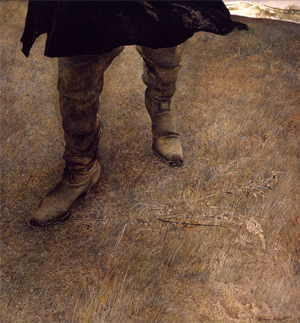
Trodden Weed, 1951, at Chadds Ford, Pennsylvania, in a private collection.
A self-portrait of the artist in wrinkled old boots given to him by his wife. The trodden down weed is barely seen.

Evening at Kuerners, 1970, at Chadds Ford, Pennsylvania, in a private collection.
A slice of American rural life. Bleak, dark, cold winter at sunset. The buildings blend in with the landscape. The pond on the right was used to farm fish and cut ice in the winter.
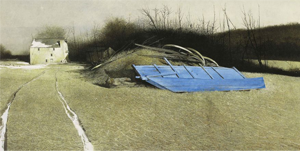
Flood Plain, 1986, at Chadds Ford, Pennsylvania, in a private collection.
An old hay wagon and two icy wheel tracks and a mill granary in the background. Wyeth said he “wanted to capture the clean swept character of the beginning of winter after the floods.”

November First, 1950, exhibited at the Smithsonian American Art Museum, Washington D.C.
An impressionist, abstract painting. Soft, dreamlike with a sense of motion.

Full Moon, 1982.
A Japanese style haiku painting capturing the moment of the moon seen through the branches of a tree. Abstract, impressionist.
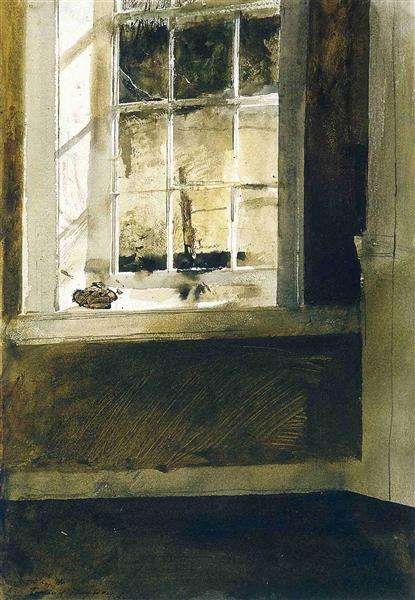
Groundhog Day, at Kurner’s Farm, Chadds Ford, Pennsylvania, 1959, exhibited at the Philadelphia Museum of Art.
Picture of Kuerner’s kitchen in the winter light. Wyeth said “I wanted to get down the essence of the man that wasn’t there.” A strong war veteran with a violent dog.

Pentacost, at an island off the coast of Maine, 1989, in a private collection.
Two tattered fishing nets hanging out to dry on a New England day. Wyeth’s wife chose the title of the Christian feast of Pentacost that “is the outpouring of God’s spirit like a mighty rushing wind.” The island had once been named Pentacost in the 1600s.
Wyeth said the spirit he sensed in the nets was that of a young girl who drowned in the sea.

Faraway, 1952, Museo Thyssen-Bornemisza, Madrid.
Portrait of Wyeth’s son Jamie in a field wearing a coonskin hat on a cold, cloudy day. A quirky glimpse of rural America. Jamie became an artist in his own right.
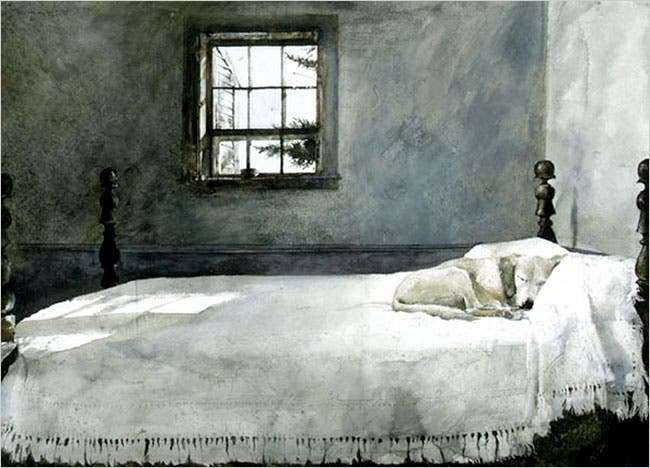
Master Bedroom, 1965, private collection.
The family dog naps on the Wyeth bed. A very popular painting. It is serene with tender simplicity, a sense of fantasy and dreaminess. The dog tells a story we ponder.

That Gentleman, 1960, Dallas Art Museum.
A solidary elderly Africa American man in a contemplative pose. The man is part in darkness with his thoughts and his hands and legs are in light ready for action. The man was Wyeth’s neighbor Tom Clark. Wyeth wrote “His voice is great, his wit is keen, and his wisdom enormous.” A quiet unsung hero.

Helga Nude, 1976, painted at Chadds Ford, Pennsylvania, in a private collection.
Surreal, abstract. Dreamlike. Similar to abstract paintings by Georgia O’Keefe and Marc Rothko.
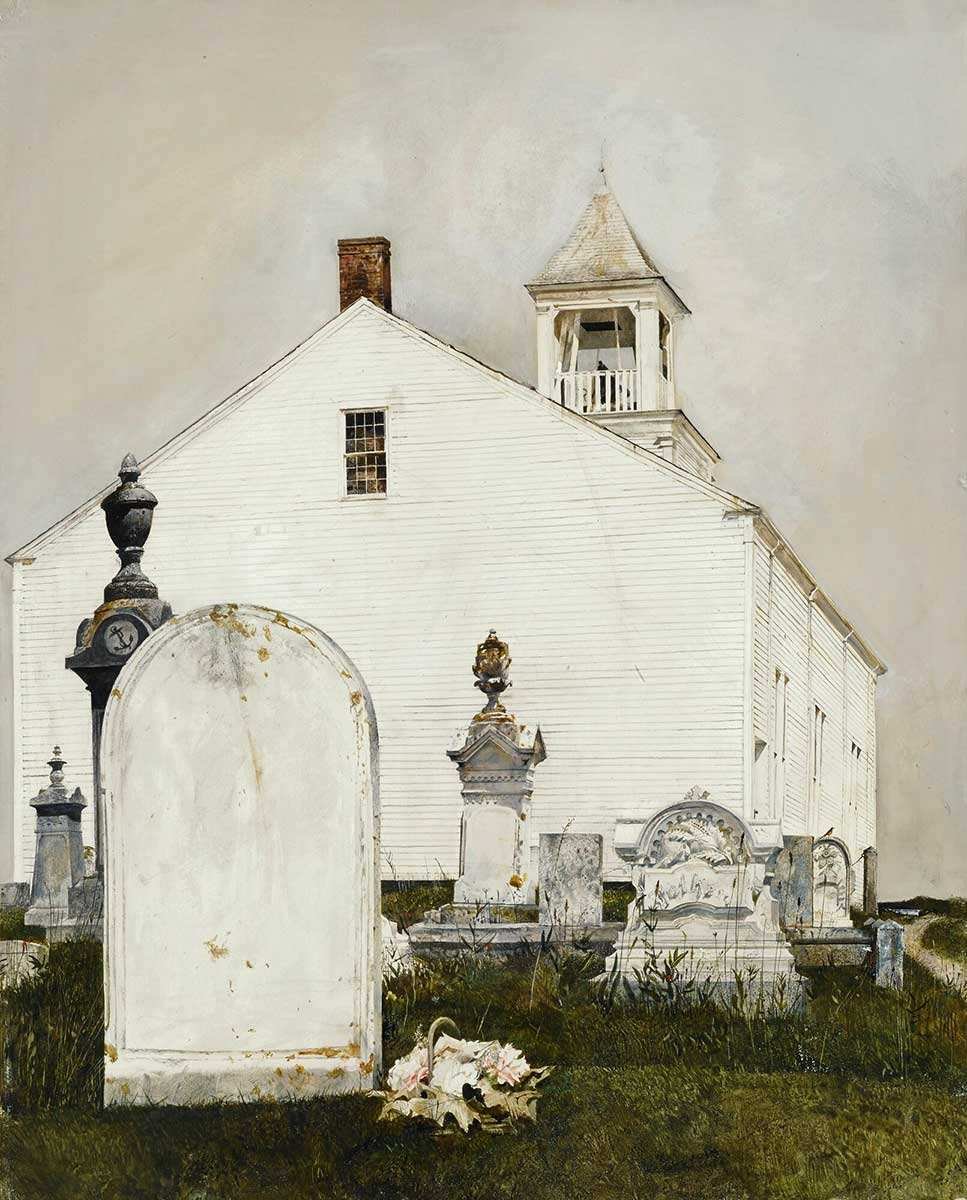
Perpetual Care, 1961, private collection.
Somber grave stones in a graveyard of the Baptist church. The title refers to the church’s role as a resting place for the souls. Markers of forgotten people and times.
References
andrtewwyeth.org
Andrew Wyeth Autobiography, Little Brown, Boston, 1995.
artworld.com
finart.ha.com
Museum of Modern Art
National Gallery of Art
Smithsonian American Art Museum
Wikipedia
Wyeth, documentary, PBS, 2018.
Wyeth’s World, documentary, BBC, 2015.



